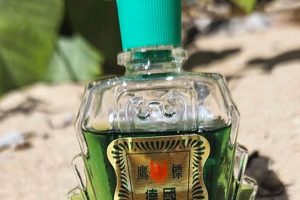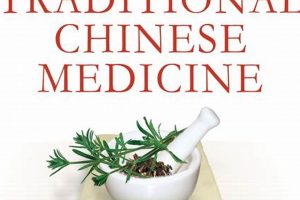Traditional therapeutic botanicals from China constitute a significant component of Traditional Chinese Medicine. These substances, derived from plants, are employed based on their specific properties and energetic actions to address imbalances within the body. Preparations can include single plants or complex formulations designed to target particular conditions.
The value of these botanical remedies lies in their holistic approach, aiming to restore harmony and balance within the individual. Historically, their use dates back millennia, forming a cornerstone of healthcare practices in China and expanding globally due to perceived effectiveness and cultural exchange. Proponents suggest that they offer complementary or alternative approaches to conventional medicine, potentially offering benefits in areas such as chronic conditions and preventative care.
The subsequent sections will delve into the specific categories, preparation methods, and contemporary research regarding the application and understanding of these important therapeutic agents, including considerations for safety and efficacy.
Guidance on Botanical Remedies from China
The following provides essential guidance when considering incorporating botanical remedies sourced from Traditional Chinese Medicine into a health regimen. This information aims to promote responsible and informed decision-making.
Tip 1: Consultation with Qualified Practitioners: Prior to initiating any regimen, consultation with a licensed and experienced practitioner of Traditional Chinese Medicine is paramount. A qualified professional can assess individual needs, medical history, and potential interactions with existing medications.
Tip 2: Source Reputable Suppliers: Procurement from verifiable and reputable suppliers is crucial. Counterfeit or adulterated substances can pose significant health risks. Look for suppliers who provide certificates of analysis confirming the identity and purity of ingredients.
Tip 3: Adherence to Dosage and Preparation: Strict adherence to prescribed dosages and preparation instructions is essential for optimizing efficacy and minimizing potential adverse effects. Deviations from recommended protocols can alter the intended therapeutic outcome.
Tip 4: Awareness of Potential Interactions: Awareness of potential interactions with conventional medications or other supplements is critical. Certain botanical remedies may amplify or diminish the effects of pharmaceutical drugs, requiring careful monitoring.
Tip 5: Monitoring for Adverse Reactions: Vigilant monitoring for any adverse reactions is necessary. Should any unexpected symptoms arise, such as skin rashes, gastrointestinal distress, or changes in vital signs, discontinue use and seek immediate medical attention.
Tip 6: Consideration of Individual Sensitivities: Individual sensitivities or allergies to specific plants should be taken into consideration. A thorough review of ingredient lists is advisable to identify potential allergens and avoid adverse reactions.
Tip 7: Understanding of Energetic Properties: Gaining a basic understanding of the energetic properties associated with various botanicals can assist in making informed choices. This knowledge can facilitate a more nuanced approach to selecting remedies that align with individual constitutions and imbalances.
Adherence to these guidelines can help ensure a safer and more effective integration of botanical remedies sourced from Traditional Chinese Medicine into a comprehensive healthcare strategy.
The concluding sections will address ongoing research and future directions in the field, highlighting the evolving understanding of these complex therapeutic agents.
1. Identification
Accurate identification forms the bedrock of safe and effective practice within the realm of botanical remedies from China. Misidentification of plant species carries significant implications, potentially leading to adverse reactions ranging from mild discomfort to severe toxicity. The complex nomenclature and regional variations in plant characteristics necessitate rigorous authentication processes, often involving experienced botanists and advanced analytical techniques. For example, Radix Aconiti, a commonly used botanical, requires careful distinction from similar-looking but less potent or more toxic Aconitum species. Improper identification could result in administering a harmful substance, negating therapeutic benefits and endangering patient health.
The reliance on visual identification alone proves insufficient in many cases. Morphological similarities between different plants, coupled with variations due to growing conditions and processing methods, render expert knowledge and advanced testing indispensable. Microscopic examination of cellular structures, chemical profiling through chromatography, and DNA barcoding offer complementary approaches to confirm the identity of botanical materials. These methods enhance quality control and mitigate the risk of adulteration or substitution, safeguarding the integrity of botanical remedies from China. A real-world example is the detection of Aristolochia species, known nephrotoxins, in supposedly safe botanical formulations, highlighting the critical role of meticulous identification in preventing harmful outcomes.
In conclusion, robust identification procedures represent a fundamental component of responsible practice. The challenges posed by plant variations and potential for misidentification necessitate the integration of expert knowledge, rigorous quality control, and advanced analytical techniques. Prioritizing accurate identification serves to protect patient safety, uphold the integrity of therapeutic applications, and ensure the continued efficacy of botanical remedies from China.
2. Preparation
Preparation methods significantly influence the efficacy and safety of botanical remedies from China. The process transforms raw plant materials into usable forms, impacting the bioavailability of active compounds and mitigating potential toxicity. Different techniques, such as decocting, powdering, pill-making, and tincturing, extract varying proportions of constituents, leading to distinct therapeutic effects. For instance, Radix Glycyrrhizae (Gan Cao) can be prepared in different ways to enhance its properties; unprocessed, it moistens the lungs, while honey-frying enhances its tonifying effects. Therefore, preparation is not merely a mechanical step, but an integral process shaping the properties of the final product.
The cause-and-effect relationship between preparation and therapeutic outcome is undeniable. Inadequate preparation can render potent botanicals ineffective or even toxic. For example, some herbs require detoxification steps, such as prolonged soaking or boiling, to remove harmful substances. Raw Radix Aconiti contains aconitine, a potent neurotoxin. Proper decoction reduces aconitine levels, making the herb safe for therapeutic use. Furthermore, combinations of different botanicals also influence preparation techniques, with some added early in decoction and others added late to preserve volatile oils or specific qualities. The method of processing and preparation affects the end product’s effects and desired result.
Understanding preparation methods is essential for achieving optimal therapeutic outcomes and ensuring patient safety. This knowledge informs the selection of appropriate preparations for specific conditions and guides practitioners in modifying techniques to suit individual needs. Ignoring the importance of preparation undermines the potential benefits of botanical remedies from China and can lead to adverse consequences. The integration of both traditional knowledge and modern scientific approaches is vital to standardize preparation procedures, optimize efficacy, and guarantee the consistent quality and safety of the final product. The success of the outcome depends greatly on the preparation processes that were followed.
3. Energetics
Energetics constitutes a foundational principle within the framework of botanical remedies from China. It attributes specific properties, actions, and therapeutic potentials to each substance, based on its perceived influence on the body’s vital energy, or Qi, and the balance of Yin and Yang. This concept goes beyond mere biochemical composition, encompassing aspects such as temperature (hot, warm, neutral, cool, cold), taste (sour, bitter, sweet, pungent, salty), and direction (ascending, descending, floating, sinking). The understanding of these energetic properties dictates the selection and combination of botanicals to address specific patterns of disharmony. For example, a condition characterized by excess heat might be treated with cooling botanicals, while deficiency of Qi may require warming and tonifying substances.
The application of energetics dictates the therapeutic approach to botanical remedies. A botanical described as “warming” is believed to invigorate the body, improve circulation, and dispel cold. Conversely, a “cooling” botanical clears heat, reduces inflammation, and calms the system. These energetic classifications are not arbitrary but are based on centuries of clinical observation and refinement. For instance, Ginseng ( Ren Shen) is categorized as warming and tonifying, used to address fatigue and strengthen the body’s Qi. Conversely, Chrysanthemum ( Ju Hua) is considered cooling, often prescribed for headaches, fever, and inflammatory eye conditions. It is vital to emphasize that the observable effects of botanical remedies, as understood in this paradigm, are inextricably linked to their energetic characteristics. These characteristics are also connected to the processing (preparation) of the herbs.
The inherent challenge lies in translating these energetic concepts into quantifiable, scientifically verifiable terms. While modern research seeks to elucidate the chemical constituents and pharmacological actions of botanical remedies, the complete understanding of their effects requires consideration of the energetic paradigm. Ignoring this aspect limits the potential to fully harness the therapeutic benefits. Future research could explore the correlations between energetic properties and specific biochemical pathways, aiming to bridge the gap between traditional knowledge and modern science. The significance of energetics to chinese herbals is paramount because it is one of the major components to create formulation, decide dosage and predict direction. Ignoring or failing to grasp this component will cause an inability to work with chinese herbals, thus creating a misunderstanding of chinese herbals.
4. Formulations
Formulations represent a cornerstone of therapeutic application within the domain of botanical remedies from China. The practice rarely involves the administration of single plants; instead, combinations of several substances are strategically assembled to address complex patterns of disharmony within the individual. These formulations are not arbitrary mixtures but are based on established principles and clinical experience, aiming to synergize the effects of individual components while mitigating potential adverse reactions.
- Synergistic Action
The principle of synergism dictates that the combined effect of the formulation is greater than the sum of its individual parts. Certain botanicals are included to enhance the actions of others, facilitate their delivery to specific organs, or counteract potential side effects. For instance, a formulation for pain relief may include a primary pain-relieving botanical, an herb to improve circulation and promote delivery of the primary botanical, and another to protect the stomach from irritation. This holistic approach seeks to address the root cause of the condition while providing symptomatic relief.
- Addressing Complex Patterns
Formulations are designed to address the multifaceted nature of disease. Often, a single condition involves multiple imbalances within the body. A formulation might simultaneously target inflammation, promote detoxification, and support the immune system. This multi-targeted approach reflects the understanding that health is a dynamic equilibrium, and therapeutic interventions must address the interconnectedness of physiological processes. The inclusion of herbs addresses multiple disease targets to treat the disease from multiple angles, and is a common strategy in these type of herbal concoctions.
- Mitigation of Toxicity
Certain potent botanicals, while possessing significant therapeutic potential, may also carry inherent risks of toxicity. Formulations often include ingredients specifically chosen to counteract or neutralize these adverse effects. For example, a formulation containing a strong “moving Qi” herb might include another herb to “guide” the Qi downwards to prevent excess energy ascending. This is not a simple calculation, as herbs can affect each other in the overall formulation. This aspect underscores the importance of expertise and careful selection of ingredients to ensure safety and efficacy.
- Individualization and Modification
While established formulas exist, a skilled practitioner will often modify these prescriptions to suit the individual patient’s unique presentation. Factors such as age, constitution, and specific symptoms are considered when adjusting the composition and dosage of the formulation. This personalized approach recognizes that each individual is unique, and a standardized treatment may not be appropriate for all. The ability to adapt and refine formulations based on clinical observation and patient feedback is a hallmark of experienced practitioners.
In summary, formulations represent a sophisticated and integral aspect of botanical remedies from China. They are carefully constructed to maximize therapeutic benefits, address complex health challenges, mitigate potential risks, and accommodate individual patient needs. The art of formulation requires a deep understanding of the properties of individual botanicals, the principles of synergism and antagonism, and the art of individualized prescription.
5. Dosage
Dosage is a critical determinant in the safe and effective application of botanical remedies from China. It constitutes the quantitative measure of each constituent plant material within a prescribed formulation. Insufficient dosage may render the therapeutic intervention ineffective, failing to elicit the desired physiological response. Conversely, excessive dosage can lead to adverse effects, ranging from mild gastrointestinal upset to severe toxicity depending on the specific plant and the individual’s constitution. Therefore, the accurate determination and administration of appropriate dosages are essential for optimizing therapeutic outcomes while minimizing potential risks. For instance, a typical dosage of Huang Qi (Astragalus root) for tonifying Qi might range from 9 to 30 grams, depending on the patient’s strength, severity of the condition, and the presence of other herbs in the formula. A dosage outside this range may prove ineffective or harmful.
The determination of appropriate dosage considers several factors. Patient-specific characteristics, such as age, weight, overall health, and concurrent medications, play a significant role. The inherent potency of the botanical material, which can vary due to growing conditions, processing methods, and storage, also influences the dosage. Furthermore, the specific combination of herbs within a formulation requires careful consideration, as certain ingredients can potentiate or antagonize the effects of others, necessitating adjustments to individual dosages. As a real-world scenario, a child’s dosage would be significantly lower than an adult’s dosage, requiring careful calculations based on weight and age. An experienced practitioner may modify a standard formula, adjusting the dosage of individual herbs based on the patient’s response and tolerance. This individualized approach underscores the importance of personalized care in the administration of botanical remedies.
Ultimately, the successful application of botanical remedies from China hinges on a precise understanding of dosage principles and the ability to tailor prescriptions to the individual patient’s needs. Challenges remain in standardizing dosages due to variations in plant quality and the complexity of herbal interactions. Ongoing research seeks to establish evidence-based guidelines for dosage determination, integrating traditional knowledge with modern scientific methods. Embracing both ancient wisdom and contemporary research is essential for maximizing the therapeutic potential of these remedies while ensuring patient safety and responsible healthcare practices. Without proper dosage, the herbs cannot effectuate their purposes. Similarly, if dosage is not properly set, it could harm the user. This is a key element in working with chinese herbals.
6. Safety
The safety profile of botanical remedies sourced from Traditional Chinese Medicine (TCM) constitutes a paramount consideration. While possessing potential therapeutic benefits, these substances are not inherently benign. Adverse effects, ranging from mild gastrointestinal discomfort to severe organ damage, can occur due to factors such as misidentification of plant species, contamination with heavy metals or pesticides, improper preparation methods, inappropriate dosage, and interactions with conventional medications. A causal relationship exists between compromised safety practices and potential harm to patients. Consequently, strict adherence to established quality control measures, accurate identification protocols, and informed prescription guidelines becomes indispensable.
The practical significance of understanding the safety aspects of TCM botanicals manifests in several critical areas. Firstly, proper training and certification of practitioners are essential to ensure they possess the necessary knowledge to accurately diagnose conditions, select appropriate remedies, and monitor for adverse reactions. Secondly, rigorous sourcing and testing of raw materials are crucial to mitigate the risks of contamination and adulteration. Thirdly, clear communication between practitioners and patients regarding potential side effects and interactions is vital for informed decision-making and proactive management of adverse events. Real-life examples of adverse reactions, such as liver damage linked to certain botanical species, underscore the importance of vigilance and responsible practices. For instance, the Aristolochia genus, known to cause nephrotoxicity and carcinogenicity, has been implicated in cases of severe kidney damage and renal failure. These occurrences emphasize the need for thorough screening and exclusion of such species from herbal formulations.
In summary, the safety of TCM botanicals is not an inherent property but rather a product of diligent quality control, informed practice, and open communication. While these remedies offer potential therapeutic value, their use carries inherent risks that must be carefully managed. By prioritizing safety at every stage, from sourcing and preparation to prescription and monitoring, it becomes possible to maximize the benefits of TCM while minimizing the potential for harm. The ongoing integration of traditional knowledge with modern scientific methods is crucial for establishing evidence-based safety guidelines and ensuring the responsible utilization of these complex therapeutic agents.
Frequently Asked Questions Regarding Botanical Remedies from China
This section addresses common inquiries and concerns related to the use of botanical remedies originating from Traditional Chinese Medicine, providing clarity and evidence-based information.
Question 1: Are Botanical Remedies from China Safe?
Safety depends on factors including proper identification, sourcing from reputable suppliers, accurate diagnosis by a qualified practitioner, and adherence to prescribed dosages. Contamination, misidentification, and interactions with conventional medications pose potential risks.
Question 2: How are Botanical Remedies from China Prepared?
Preparation methods vary widely, influencing the therapeutic properties and potential toxicity. Common techniques include decocting (boiling), powdering, and tincturing. Proper preparation is essential for optimizing efficacy and minimizing adverse effects.
Question 3: Can Botanical Remedies from China Interact with Conventional Medications?
Yes, significant interactions can occur. Certain botanicals may amplify or diminish the effects of pharmaceutical drugs. Disclosure of all medications and supplements to a qualified practitioner is crucial.
Question 4: Are There Quality Control Standards for Botanical Remedies from China?
Quality control standards vary across regions and suppliers. Look for suppliers providing certificates of analysis confirming ingredient identity and purity. Independent testing and verification are recommended.
Question 5: How are Botanical Remedies from China Prescribed?
Prescriptions are individualized based on a comprehensive assessment of the patient’s condition, including symptoms, medical history, and energetic imbalances. A qualified practitioner tailors formulations and dosages to the individual’s specific needs.
Question 6: What is “Energetics” in the Context of Botanical Remedies from China?
Energetics refers to the inherent properties attributed to each botanical, such as temperature (hot, cold) and taste (sweet, bitter), which are believed to influence the body’s vital energy (Qi) and the balance of Yin and Yang. Understanding energetics guides the selection and combination of botanicals.
These FAQs highlight the complexities associated with the use of botanical remedies. Informed decision-making and consultation with qualified practitioners are paramount for ensuring safety and efficacy.
The following discussion examines future research directions and the ongoing evolution of understanding surrounding these therapeutic agents.
Conclusion
The exploration of chinese herbals reveals a complex system of therapeutic agents requiring rigorous study and responsible application. Key considerations encompass accurate identification, appropriate preparation, an understanding of energetic properties, strategic formulation, precise dosage, and a commitment to safety. The integration of traditional knowledge with contemporary scientific methods holds the key to unlocking the full potential of these remedies while mitigating inherent risks.
Further research and standardization are essential to establish evidence-based guidelines and ensure the consistent quality and safety of chinese herbals. Ongoing efforts to bridge the gap between traditional practices and modern scientific understanding will shape the future of this field, potentially offering valuable contributions to global healthcare. The responsible and informed utilization of chinese herbals demands a continued commitment to education, rigorous quality control, and collaborative dialogue between practitioners, researchers, and regulatory bodies.







